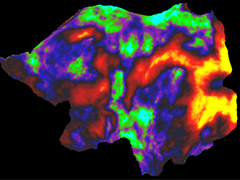The NIH announced December 3, 2018 that enrollment for the landmark Adolescent Brain Cognitive Development (ABCD) Study is now complete and, in early 2019, scientists will have access to baseline data from all ABCD Study participants. There are over 11,874 youth, ages 9-10, participating in the study at 21 research sites around the country, including the University of Vermont (UVM).

(Image: Philip Spechler, M.A., University of Vermont doctoral student)
The National Institutes of Health (NIH) announced December 3, 2018 that enrollment for the landmark Adolescent Brain Cognitive Development (ABCD) Study is now complete and, in early 2019, scientists will have access to baseline data from all ABCD Study participants.
There are over 11,874 youth, ages 9-10, participating in the study at 21 research sites around the country, including the University of Vermont (UVM). Participants include 577 Vermont youth and 2,100 young people who are twins or triplets. All will be followed through to young adulthood during this ten-year study.
The ABCD Study’s aim is to increase understanding of environmental, social, genetic, and other biological factors that affect brain and cognitive development and can enhance or disrupt a young person’s life trajectory. The study is supported by ten NIH institutes and offices, as well as the Centers for Disease Control and Prevention and other federal partners.
The study will use advanced neuroimaging to observe brain development in children throughout adolescence, while tracking social, behavioral, physical and environmental factors that may affect brain development and other health outcomes.
Anonymized study data are being made available to the broad research community on a regular basis. This will allow scientists to analyze data and ask novel questions that were not even anticipated in the original study planning. Offering these data while the study is in progress means that both ABCD investigators and non-ABCD researchers will have access to the datasets to pursue their own research interests.
There are many health topics that are of interest to researchers, policy makers, educators, parents, and the participants themselves, which scientists can now study using the baseline assessment data. These data can then be tracked over time and used to make predictions as youth develop and are shaped by their life experiences. Scientists can look at brain characteristics associated with impulsive action or early psychopathology; the impact of health behaviors (e.g., sleep, physical activity) on cognitive and brain development; or traits associated with media use, including screen time exposure. For example, a recent study by ABCD investigators showed associations between differing amounts and kinds of screen time (e.g., video games vs. social media) and different structural brain characteristics, psychological traits, and cognitive function. Scientists will be able to follow participants over time to understand how media use will influence a person’s development, underscoring the unique opportunity provided by the ABCD study.
Similarly, researchers can look at risk and resilience factors for mental illness and substance use, including genetics, family history, traits such as impulsivity, and exposure to positive and negative environmental events. With longitudinal data, the developmental trajectories of the participants can be tracked to better understand these complex relationships, and eventually to improve prevention or mitigate risks for adverse outcomes.
Additional data from the first 4,500 children enrolled in the study were released last month, and data from the full participant cohort (11,874) will be available in early 2019. In addition, scientists will be able to access a new tool through the NIMH Data Archive — the Data Exploration and Analysis Portal (DEAP). DEAP will facilitate analysis of the ABCD data, allowing users to analyze the data online without downloading them, while providing appropriate statistical models and tools that take advantage of the ABCD Study design. DEAP will enhance the ability of researchers to address myriad questions related to adolescent development.
Researchers interested in accessing these data can visit the NIMH Data Archive. As findings are published in various journals by both ABCD investigators and other scientists, study coordinators will continue to post information on the study website at https://abcdstudy.org.
In Vermont, the study is being co-led by Alexandra Potter, Ph.D., associate professor of psychiatry, and Hugh Garavan, Ph.D., professor of psychiatry, at UVM’s Larner College of Medicine. They and their colleagues, who include 12 UVM undergraduate students serving as part-time research assistants, recruited participants from 39 schools across the state.
(This release was adapted with permission from a news release produced by the Public Information and Liaison Branch of the Office of Science Policy and Communications at the NIH's National Institute on Drug Abuse.)